Wednesday, April 07, 2010
Hollandaise Sauce
Of late I find myself surrounded by people who love this thing. There's Vijay with his penchant for lots of butter ("...more butter on that toast please?") and more than a handful of friends who order eggs Benedict for brunch. A most recent outing with Zarina finally convinced me to try making it despite my lack of interest in traditional French mother sauces - béchamel, espagnole, velouté (I first tasted this at Blue Basil) and allemande.

I'd sooner make an aioli, mayonnaise (another favorite of the other half, although I suspect so because he haven't tasted many other sauces) or mushroom sauce because those are more often applied to my cooking. With all that effort and concentration, not to mention a certain degree of stress involved in worrying of screwing it up, I'd like to be able to keep a jar in the fridge to be savored with other dishes later.
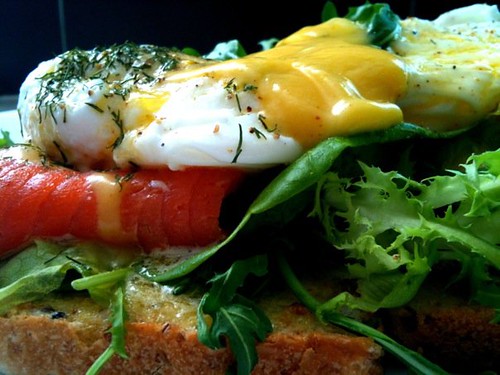
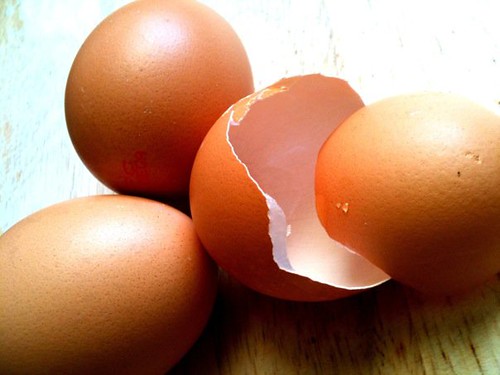


The practicality of this sauce is a concern to me. It's to be served immediately (no longer than one hour after preparation), easy to turn into very tasty scrambled eggs and not meant for long storage. A standard recipe yields one and a half cups which in sensible dosage serves up to six people. However, I decided that since I'm ready to rise to the challenge of making it already, this will be a good chance to test the storage and revival methods suggested from various sources on the Net. I made the sauce for (a variation of) eggs Benedict for the day and used it for over a piece of seared salmon steak the next afternoon.
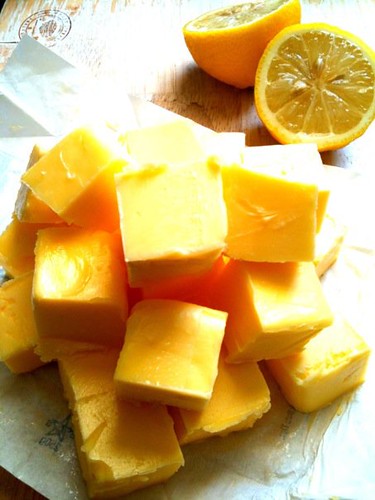
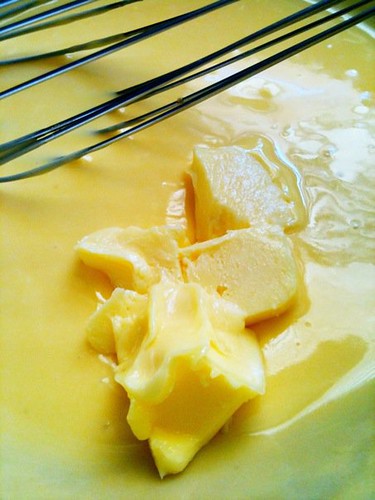


I have the blessings of facing not too many mishaps in the kitchen. My worst experience working with eggs were during the endeavor to poach them and another (very, very, very) bad one on Valentine's Day of 2008 while trying to make chocolate cream for the dessert of our romantic dinner (I had enough eggs for four botched attempts but had to ask Vijay to get me extra chocolate).
My rather industrious mucking around knobs of butter was successful however, though not without some minor drama due to my tired recovering foot and act of juggling photo taking while whisking and handling hot mixing bowl. I couldn't locate my mother's measuring spoons after the kitchen renovation and had to wing it by estimation (I figured for a sauce winging it should be fine, it's not like baking). A fourth egg had to be retrieved from the fridge after I broke one in the sink trying to save two eggs rolling off the chopping board (in service to that picture above).

There are countless of recipes online of course, but Google is smart enough to list out Alton Brown's as one of them. I was somehow confident that his will work. Having watched season after season of his scientific and no nonsense Food Network show Good Eats, I like his simple and accurate approach to making tasty food. I mean, some recipes online call for blitzing the sauce in a blender (this doesn't make sense to me as I've seen TV chefs making the sauce only by whisking) and others even suggested cooking the egg on direct low heat. The secret to this emulsion sauce is simple. Keep the heat low, the lowest possible on your hob. The egg yolks need very little steam to thicken and once the consistency is right, everything else should fall into place nicely and you will not lament over unintentional scrambled eggs anytime.

I believe you may add more lemon juice than suggested as mine turned out a little less tart than I'd prefer. It will split when in contact with heat so if dressing it on warm food serve immediately. A better (and more difficult) way to make the sauce if to use clarified butter as chefs do at restaurants. The discarded water and milk solids will yield a smoother result.
Clarified Butter
In a heavy-based saucepan, melt the butter. Simmer it rapidly for at least 10 minutes. The water will evaporate and the milk solids will coagulate on the bottom and sides of the pan. Let the melted butter sit for a few minutes so the solids will fall to the bottom. Skim off the foam on top and then either decant the golden liquid, leaving the solids behind, or pour the melted butter through a cheesecloth-lined strainer.
To keep hollandaise sauce warm up to two hours, seal in a thermos. If making up to four days ahead, pour into a jar and chill airtight. To serve, let stand about two hours at room temperature, then whisk to soften. This approach is proven, as the day after making the sauce, I whisked up the room temperature hollandaise into a similar smooth consistency to serve with my salmon. Now what else can I do with the rest of the sauce?
Hollandaise Sauce
Recipe from Alton Brown for Food Network
Makes approximately 1 1/2 cups
- 3 egg yolks
- 1 teaspoon water
- 1/4 teaspoon sugar
- 12 tablespoons (1 1/2 sticks) unsalted butter, chilled and cut into small pieces
- 1/2 teaspoon kosher salt
- 2 teaspoon freshly squeezed lemon juice
- 1/8 teaspoon cayenne pepper
Pour 1-inch of water into a large saucepan; over medium heat, bring to a simmer. Once simmering, reduce the heat to low. Keep the water to one inch and use a saucepan which supports the width of your mixing bowl. Use the lowest heat possible on your hob and ensure that the water is only simmering very slightly (I kept it pretty still but at the same time releasing some steam).
Place egg yolks and 1 teaspoon water in a medium mixing bowl and whisk until mixture lightens in color, approximately 1 to 2 minutes. Add the sugar and whisk for another 30 seconds. Beware not to over whisk at this stage, this is just to combine the sugar and eggs.
Place the mixture over the simmering water and whisk constantly for 3 to 5 minutes, or until there is a clear line that is drawn in the mixture when you pull your whisk through, or the mixture coats the back of a spoon. This is the stage of creating the initial emulsion, a sabayon. Getting the correct thickness will determine how thick the sauce will be when it cools a little. A runny hollandaise is unattractive, but overcooking the sabayon will cause curdling and result in... you're right, scrambled eggs. Curdling in this stage cannot be rescued, but at least no butter is wasted yet, so start over with new eggs.
Remove the bowl from over the pan and gradually add the butter, 1 piece at a time, and whisk until all of the butter is incorporated. Place the bowl back over the simmering water occasionally so that it will be warm enough the melt the butter. This stage is to create the second emulsion. Add the first piece of butter immediately after the sabayon has reached the right consistency. If you let it sit, it will thicken. After the initial few pieces of butter, the sauce will thicken and when placed on the water the butter will melt gently, thinning the sauce. Go off the heat and continue adding the butter a few pieces at a time and repeat the off water, on water action.
Overheating the sauce at this stage will cause the sauce to split (or separate). You will end up with a sad looking, grainy sauce and oily butter at the edges. If this happens, it can usually be quickly repaired by very slowly beating the warm sauce into a yolk that has first been whisked vigorously with a tablespoon of cold water or heavy cream. (You're basically starting the emulsion process over.) A repaired sauce won't be as light, but it will taste the same.
Add the salt, lemon juice, and cayenne pepper. Serve immediately or hold in a thermos to keep warm. Go off the heat here as the final three ingredients can combine well in the already warm sauce. Let the sauce cool down a little and it will thicken to the right consistency.
Life Is Great explores the incredible world of food and cooking. We hope to share with you our most delicious moments and inspirations.
“Just like becoming an expert in wine–you learn by drinking it, the best you can afford–you learn about great food by finding the best there is, whether simply or luxurious. The you savor it, analyze it, and discuss it with your companions, and you compare it with other experiences.”
Julia Child (Mastering the Art of French Cooking)
“Life is short. Live your dream and share your passion.”
- Gooey Cinnamon Cake
- Chinese Crispy Roast Pork Belly (Siu Yuk 烧肉)
- ABC Soup (罗宋汤)
- Kong Bak Pau (扣肉包)
- Pandan Chiffon Cake (Improved)
- Crispy Fried Egg
- Tamago Kake Gohan (卵かけご飯)
- Strawberry Pie
- One Pot Chicken Rice
- Bak Chor Mee (肉脞面 - Minced Pork Noodle)
- Hakka Salted Egg Steamed Pork (咸蛋蒸猪肉)
- Hong Kong Part III
- Hong Kong Part II: Zongzi/Bakchang (粽子/肉粽)
- Caffè HABITŪ (the table) at G.O.D. Causeway Bay, Hong Kong
- Hong Kong Part I
- Australia 2010 Part 1: Melbourne
- Bourke Street Bakery, Sydney
- Il Fornaio, St Kilda
- Queen Victoria Market, Melbourne



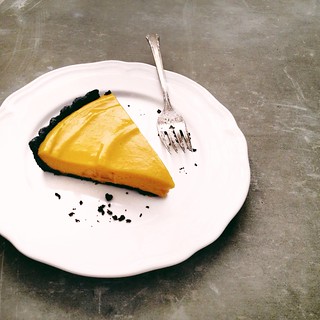


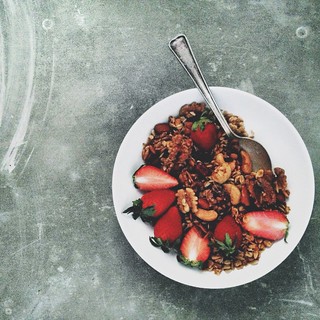
2 Comments on Hollandaise Sauce
Tried this on top of asparagus and salmon tonight. Excellent!
Posted by Anonymous, at
Dec 31, 2012, 9:44:00 AM
Anonymous, at
Dec 31, 2012, 9:44:00 AM
Anon: Thanks, Alton's recipes mostly work!
Posted by PickYin, at
Jan 2, 2013, 10:47:00 AM
PickYin, at
Jan 2, 2013, 10:47:00 AM
Post a Comment